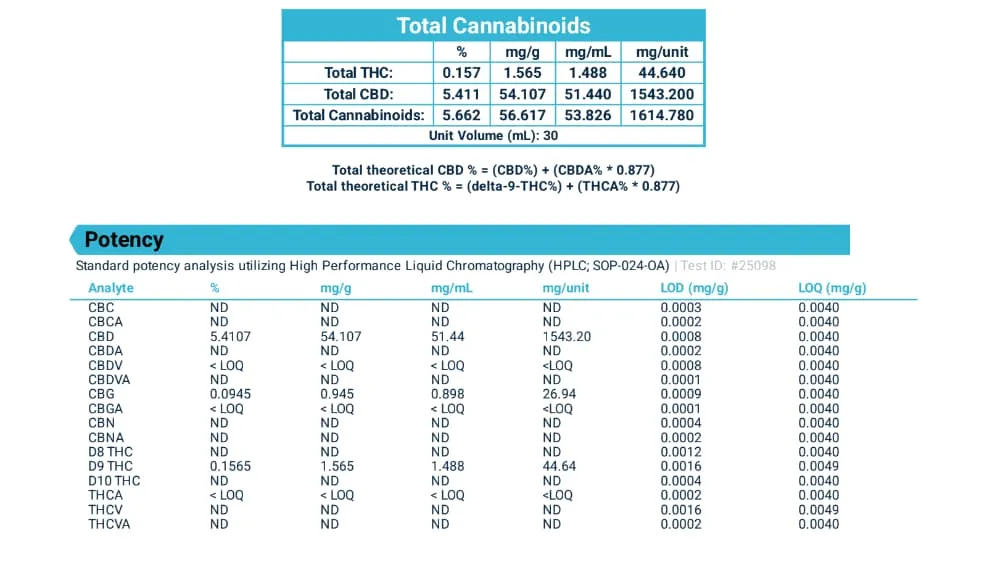No products in the cart.
Understanding Your CBD Oil’s Certificate Of Analysis

Key Takeaways
- COAs a technical documents that confirm that your product meets certain specifications.
- COAs often present CBD potency in terms of weight, a measure that may not be helpful for liquid products that are often measured in volume.
- You can use weight measurements to determine volumetric potency with a little math.
If you’re considering buying CBD oil soon and want to ensure that you’re only getting the best, you’ll want to look at your product’s certificate of analysis. Often shortened to “COA,” certificates of analysis are technical documents produced by accredited third-party labs that confirm that a product meets certain specifications.
When you look at a specific CBD Oil’s COA, it should tell you,
- How much CBD is in the bottle.
- How much delta-9 THC is present, if at all.
- And what the concentration of cannabinoids in oil is.
In the rest of this post, we’ll explain how to find those numbers and what they mean, using examples from our 1500mg Full Spectrum CBD Oil Tincture to help us better understand CBD Oil’s certificates of analysis.
Reading Your CBD Oil’s Certificate Of Analysis

The above image is the cannabinoid profile from Sunset Lake CBD’s 2024 1500mg CBD Oil Tincture potency test. You can find the entire test on our “Quality Tests” page.
Most companies will host their COAs online, but don’t worry if you can’t find them. We have a post about finding certificates of analysis, too!
Total Cannabinoids
You’ll notice that at the top of the section, we have a table titled “Total Cannabinoids.” This top-level summary of our product is helpful and should tell us all we need to know most of the time. But, for the sake of this post, we’ll also explore the potency table below.
The two columns that will tell us the most information are the two on the right,
- mg/mL – This column tells us how many milligrams of the highlighted cannabinoid are present in one milliliter of our CBD oil. For reference, most droppers that come with CBD Oil Tinctures have a marked 1mL fill line. We generally measure potency based on this number.
- mg/unit – This column tells us how many milligrams of the highlighted cannabinoids are in the bottle. Our 1500mg CBD Oil Tincture tested at 1543mg of CBD per bottle. It also tested at 44mg of THC per bottle. That may sound like a lot, but if it is spread out over 30 one-milliliter doses, it’s much more manageable.
Underneath this table, we have more information about our product and the cannabinoid conversion equations that our lab used to glean total cannabinoid numbers.
Related: What is Decarboxylation?
The lab that Sunset Lake uses for its manufactured products is great because it provides this information about total CBD per unit and mL right there in our total cannabinoid summary. A lot of labs don’t do this— at least not yet.
So what happens when your CBD Oil’s COA doesn’t have this information?
Reading The Potency Table
If your COA doesn’t come complete with potency and package information, we must turn to our “Potency Table” and a little back-of-the-napkin math to find our answers.
Let’s again use the table above. For our sake, let’s define some of the columns so that we can figure out what they mean.
- Analyte – Another word for what’s being analyzed. In this case, it means cannabinoids.
- % – This column tells us what percentage of the sample’s weight the analyte makes up. It is handy for most products, but for a liquid like CBD Oil, not so much.
- mg/g – This column again tells us about weight, but the units change. You’ll notice that the numbers are the same as the % column, but the decimal point is moved over one place.
- mg/mL – This column tells us about potency, specifically how many milligrams of CBD are in a milliliter of oil.
- mg/unit – This column tells us how many milligrams are in a bottle of our oil. This number should match the advertised level on the label.
- LOD – Limits of detection is the lowest amount needed to be detected by this lab’s tools. If the analyte is present in an amount lower than this, it will be marked “ND,” meaning it is non-detectable.
- LOQ – Limits of quantification is the lowest percentage at which the lab can give you an actual percentage for the analyte.
As mentioned, many certificates of analysis don’t contain mg/mL or mg/unit information. If that’s true with your CBD’s COA, let’s figure out that information ourselves.
Understanding Our CBD Oil’s Potency
Let’s determine how many milligrams of CBD are in a single dose (1mL) of our 1500mg CBD Oil Tincture. First, we start with our weight analysis; one gram of this formula contains 54.107mg of CBD.
Step 1: Carrier Oil Lookup
First, we need to look up the density of our carrier oil. Sunset Lake uses organic MCT oil, which weighs 0.95 grams per mL.
Other common carrier oils include,
- Hemp seed oil – 0.930 g/mL
- Olive oil – 0.92 g/mL
- Palm oil – 087 – 0.91 g/mL
Step 2: Canceling Variables
Our 1500mg CBD Oil Tincture contains 30 mL of CBD-infused oil, so let’s multiply our total volume (30 mL) by the weight of our oil (0.95g/mL). Our multiplication cancels out the mL variable, leaving us with 28.5g.
Step 3: Multiplying For Total CBD
We must multiply 28.5 grams by our “Total CBD” concentration (54.1mg/g) to find our total milligrams per bottle.
54.1mg/g x 28.5g = 1,541 mgThat’s a bit higher than the 1500mg mark but still within the allowed 10% (150mg) margin of error.
Step 4: Dividing For CBD Per Dose
Now that we’ve double-checked our per-package potency against our label let’s find out how much CBD we’ll get in a standard dose of 1mL.
1,541mg / 30mL = 51.36 mg/mL Wrapup
Learning how to read your CBD oil’s certificates of analysis will make you a smarter shopper and help you find an oil that works best for you.
If you’re ready to learn more about COAs in general, including full-panel results, how to understand contaminant profiles, and what else to look for, see our long-form post about how to read a certificate of analysis here.
